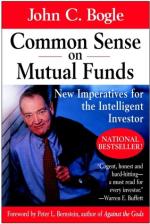A hedge fund is a pooled investment fund that trades in relatively liquid assets and is able to make extensive use of more complex trading, portfolio-construction, and risk management techniques in an attempt to improve performance, such as short selling, leverage, and derivatives. Financial regulators generally restrict hedge fund marketing to institutional investors, high net worth individuals, and accredited investors.
Passive management is an investing strategy that tracks a market-weighted index or portfolio. Passive management is most common on the equity market, where index funds track a stock market index, but it is becoming more common in other investment types, including bonds, commodities and hedge funds.
An index fund is a mutual fund or exchange-traded fund (ETF) designed to follow certain preset rules so that the fund can track a specified basket of underlying investments. While index providers often emphasize that they are for-profit organizations, index providers have the ability to act as "reluctant regulators" when determining which companies are suitable for an index. Those rules may include tracking prominent indexes like the S&P 500 or the Dow Jones Industrial Average or implementation rules, such as tax-management, tracking error minimization, large block trading or patient/flexible trading strategies that allow for greater tracking error but lower market impact costs. Index funds may also have rules that screen for social and sustainable criteria.
A mutual fund is an investment fund that pools money from many investors to purchase securities. The term is typically used in the United States, Canada, and India, while similar structures across the globe include the SICAV in Europe and open-ended investment company (OEIC) in the UK.
An exchange-traded fund (ETF) is a type of investment fund and exchange-traded product, i.e. they are traded on stock exchanges. ETFs are similar in many ways to mutual funds, except that ETFs are bought and sold from other owners throughout the day on stock exchanges whereas mutual funds are bought and sold from the issuer based on their price at day's end. An ETF holds assets such as stocks, bonds, currencies, futures contracts, and/or commodities such as gold bars, and generally operates with an arbitrage mechanism designed to keep it trading close to its net asset value, although deviations can occasionally occur. Most ETFs are index funds: that is, they hold the same securities in the same proportions as a certain stock market index or bond market index. The most popular ETFs in the U.S. replicate the S&P 500, the total market index, the NASDAQ-100 index, the price of gold, the "growth" stocks in the Russell 1000 Index, or the index of the largest technology companies. With the exception of non-transparent actively managed ETFs, in most cases, the list of stocks that each ETF owns, as well as their weightings, is posted daily on the website of the issuer. The largest ETFs have annual fees of 0.03% of the amount invested, or even lower, although specialty ETFs can have annual fees well in excess of 1% of the amount invested. These fees are paid to the ETF issuer out of dividends received from the underlying holdings or from selling assets.
The Vanguard Group, Inc. is an American registered investment advisor based in Malvern, Pennsylvania, with about $7 trillion in global assets under management, as of January 13, 2021. It is the largest provider of mutual funds and the second-largest provider of exchange-traded funds (ETFs) in the world after BlackRock's iShares. In addition to mutual funds and ETFs, Vanguard offers brokerage services, educational account services, financial planning, asset management, and trust services. Several mutual funds managed by Vanguard are ranked at the top of the list of US mutual funds by assets under management. Along with BlackRock and State Street, Vanguard is considered to be one of the Big Three index fund managers that dominate corporate America.

Value investing is an investment paradigm that involves buying securities that appear underpriced by some form of fundamental analysis. The various forms of value investing derive from the investment philosophy first taught by Benjamin Graham and David Dodd at Columbia Business School in 1928, and subsequently developed in their 1934 text Security Analysis.

John Clifton "Jack" Bogle was an American investor, business magnate, and philanthropist. He was the founder and chief executive of The Vanguard Group, and is credited with creating the index fund. An avid investor and money manager himself, he preached investment over speculation, long-term patience over short-term action, and reducing broker fees as much as possible. The ideal investment vehicle for Bogle was a low-cost index fund held over a lifetime with dividends reinvested and purchased with dollar cost averaging.
Buy and hold, also called position trading, is an investment strategy whereby an investor buys financial assets or non-financial assets such as real estate, to hold them long term, with the goal of realizing price appreciation, despite volatility.
In finance, an investment strategy is a set of rules, behaviors or procedures, designed to guide an investor's selection of an investment portfolio. Individuals have different profit objectives, and their individual skills make different tactics and strategies appropriate. Some choices involve a tradeoff between risk and return. Most investors fall somewhere in between, accepting some risk for the expectation of higher returns. Investors frequently pick investments to hedge themselves against inflation. During periods of high inflation investments such as shares tend to perform less well in real terms.

Asset allocation is the implementation of an investment strategy that attempts to balance risk versus reward by adjusting the percentage of each asset in an investment portfolio according to the investor's risk tolerance, goals and investment time frame. The focus is on the characteristics of the overall portfolio. Such a strategy contrasts with an approach that focuses on individual assets.

A stock trader or equity trader or share trader, also called a stock investor, is a person or company involved in trading equity securities and attempting to profit from the purchase and sale of those securities. Stock traders may be an investor, agent, hedger, arbitrageur, speculator, or stockbroker. Such equity trading in large publicly traded companies may be through a stock exchange. Stock shares in smaller public companies may be bought and sold in over-the-counter (OTC) markets or in some instances in equity crowdfunding platforms.

Dodge & Cox is an American mutual fund company, founded in 1930 by Van Duyn Dodge and E. Morris Cox, that provides professional investment management services.
Joel Greenblatt is an American academic, hedge fund manager, investor, and writer. He is a value investor, alumnus of the Wharton School of the University of Pennsylvania, and adjunct professor at the Columbia University Graduate School of Business. He runs Gotham Asset Management with his partner, Robert Goldstein. He is the former chairman of the board of Alliant Techsystems (1994–1995) and founder of the New York Securities Auction Corporation. He was a director at Pzena Investment Management, a firm specializing in value investing and asset management for high-net worth clients.
Fundamentally based indexes or fundamental indexes, also called fundamentally-weighted indexes, are indexes in which stocks are weighted according to factors related to their fundamentals such as earnings, dividends and assets, commonly used when performing corporate valuations. Indexes that use a composite of several fundamental factors attempt to average out sector biases that may arise from relying on a single fundamental factor. A key belief behind the fundamental index methodology is that underlying corporate accounting/valuation figures are more accurate estimators of a company's intrinsic value, rather than the listed market value of the company, i.e. that one should buy and sell companies in line with their accounting figures rather than according to their current market prices. In this sense fundamental indexing is linked to so-called fundamental analysis.
Tactical asset allocation (TAA) is a dynamic investment strategy that actively adjusts a portfolio's asset allocation. The goal of a TAA strategy is to improve the risk-adjusted returns of passive management investing.
"The Superinvestors of Graham-and-Doddsville" is an article by Warren Buffett promoting value investing, published in the Fall, 1984 issue of Hermes, Columbia Business School magazine. It was based on a speech given on May 17, 1984, at the Columbia University School of Business in honor of the 50th anniversary of the publication of Benjamin Graham and David Dodd's book Security Analysis. The speech and article challenged the idea that equity markets are efficient through a study of nine successful investment funds generating long-term returns above the market index. All these funds were managed by Benjamin Graham's alumni, following the same "Graham-and-Doddsville" value investing strategy but each investing in different assets and stocks.

Common Sense on Mutual Funds: New Imperatives for the Intelligent Investor, written by John Bogle, is a book advising investors about mutual funds, with a focus on the praise of index funds and the importance of having a long-term strategy. On the dust jacket cover, Jim Cramer wrote, "After a lifetime of picking stocks, I have to admit that Bogle's arguments in favor of the index fund have me thinking of joining him rather than trying to beat him."

An investment fund is a way of investing money alongside other investors in order to benefit from the inherent advantages of working as part of a group such as reducing the risks of the investment by a significant percentage. These advantages include an ability to:
The SPDR S&P 500 ETF trust is an exchange-traded fund which trades on the NYSE Arca under the symbol SPY. SPDR is an acronym for the Standard & Poor's Depositary Receipts, the former name of the ETF. It is designed to track the S&P 500 stock market index. This fund is the largest and oldest ETF in the world. SPDR is a trademark of Standard and Poor's Financial Services LLC, a subsidiary of S&P Global. The ETF's CUSIP is 78462F103 and its ISIN is US78462F1030. The trustee of the SPDR S&P 500 ETF Trust is State Street Bank and Trust Company. The fund has a net expense ratio of 0.0945%. The value of one share of the ETF is worth approximately 1/10 of the cash S&P 500's current level. On December 1, 2021, the 30-Day average daily volume range for the past 5 years was 82.45 million shares, making it the ETF with the largest trading volume. The sponsor is SPDR Services LLC, a wholly owned subsidiary of American Stock Exchange LLC. Dividends are distributed quarterly, and are based on the accumulated stock dividends held in trust, less any expenses of the trust. The trust seeks to provide investment results that, before expenses, correspond generally to the price and yield performance of the S&P 500 index.







